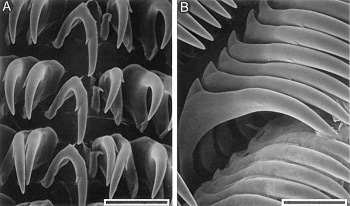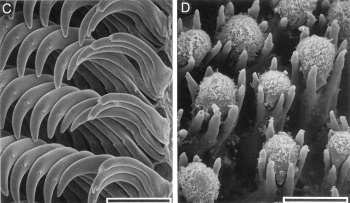

Rostanga aureamala
- Radula
PHOTO
(A) Inner lateral teeth, scale = 60 µm, (B) mid-lateral teeth, scale = 60 µm, (C) outer lateral teeth, scale = 75 µm, (D) carophyllidia, scale = 75 µm. PHOTOS: Darrel Ubick
The labial cuticle is smooth, with no jaws. There is a small central rachidian tooth in each row (A). The inner lateral teeth are denticulate, each one having a single denticle on the outer side of the cusp (A). The teeth gradually increase in size from the innermost to the mid-lateral teeth. The mid-lateral teeth are denticulate; each one having a very small denticle on the outer side of the cusp, approx. halfway between the base of the cusp and its end (B). The outer lateral teeth are elongate and slender, but shorter than the mid-laterals (C). The two outermost teeth are trifid, with short denticles at their end of the cusps. The other outer lateral teeth have only one denticle, closer to the middle of the cusp, on the outer face. The outermost teeth are not much smaller than the other laterals.
Rostanga aureamala is clearly distinguishable from the other members of the genus in having rachidian teeth in the radula. The innermost lateral teeth are similar to those of R. elandsia but the outermost teeth differ (bifid in R. elandsia, trifid in R. aureamala).
Reference:
• Garovoy, J.B., Valdés, A., & Gosliner, T.M. 2001. Phylogeny of the genus Rostanga (Nudibranchia), with descriptions of three new species from South Africa. Journal of Molluscan Studies 67: 131-144.
Rudman, W.B., 2002 (February 15) Rostanga aureamala - Radula. [In] Sea Slug Forum. Australian Museum, Sydney. Available from http://www.seaslugforum.net/factsheet/rostaurerad
